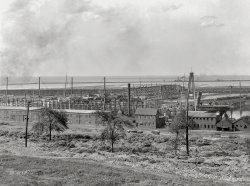
MAY CONTAIN NUTS

Search Shorpy
SHORPY ART

Framed or unframed, desk size to sofa size, printed by us in Arizona and Alabama since 2007. Explore now.
Join and Share
Ad-Free Shorpy
Shorpy is funded by you. Patreon contributors get an ad-free experience.
Learn more.

Recent comments
- Baked goods to go
- Tires
- A Certain Robot
- Still Standing
- All wound up?
- Springy
- This one is inspirational.
- Seasonal Work
- Tomaeto, Tomahto
- Truck ID
- Horton Hears a ...
- From a buggy company came ...
- They call me Mister Horton
- Still Run
- Someone fed Jack some bad info.
- A Beautiful Machine
- It's official.
- Olive Brand Sportswear
- I still have a grudge against Texaco
- No GPS?
- CFG Bank Arena
- Van Lines
- Closed Station?
- John Vachon
- Folding Chairs
- TEXAGO
- Fragi-lay
- Classy
- Passenger seat
- No tipping
Member Photos
The Shorpy
Printporium
Printporium
Search Shorpy
Search results -- 30 results per page
- Thurston Lee: 1943
- ... into a dormitory at the Atchison, Topeka, and Santa Fe Railroad yard." Medium-format safety negative by Jack Delano for the Office of War ... Posted by Dave - 12/26/2012 - 9:56pm -
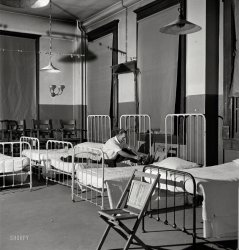
- Industrial Omaha: 1938
- November 1938. "Nebraska Power Co. plant and railroad yard at Omaha." Medium format negative by John Vachon for the Farm Security ... Posted by Dave - 06/08/2019 - 4:02pm -
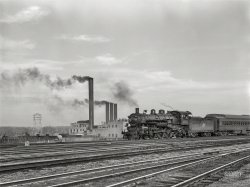
- Illinois Central: 1942
- ... Illinois. Engine taking on coal at an Illinois Central Railroad yard." Medium-format negative by Jack Delano. View full size.
Parts ... Posted by Dave - 07/21/2014 - 12:40pm -
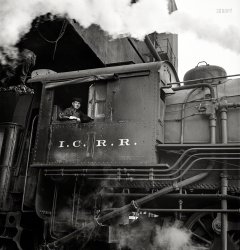
- Domeliner: 1940
- September 1940. Washington, D.C. "Railroad tracks with view of the U.S. Capitol in background." Photo by Edwin ... was completed on this stretch of track to Potomac Yard near Alexandria, VA in early 1935.
(The Gallery, D.C., Edwin Rosskam, ... Posted by Dave - 07/21/2013 - 1:10pm -
![Domeliner: 1940 September 1940. Washington, D.C. "Railroad tracks with view of the U.S. Capitol in background." Photo by Edwin Rosskam. View full size.
No CoincidenceThat the Capitol dome appears to be straight down the track at this point, since the rails follow the alignment of Maryland Avenue, SW, one of the avenues radiating from the Capitol. Just below the catenary they curve to follow the alignment of Virginia Avenue, SW, then turn into a tunnel to Union Station. Behind the photographer, they cross the Long Bridge into Virginia.
[Here's a Google Street View. -tterrace]
View Larger Map
23 Years before...Seen here on Shorpy. This must have been a favorite vantage point! The PRR's electrification was completed on this stretch of track to Potomac Yard near Alexandria, VA in early 1935.
(The Gallery, D.C., Edwin Rosskam, Railroads)](https://www.shorpy.com/files/images/SHORPY_8b31579a.thumbnail.jpg)
- Field of Wheels: 1942
- ... axles outside the locomotive shops at an Illinois Central Railroad yard." Medium-format nitrate negative by Jack Delano for the Office of War ... Posted by Dave - 02/04/2016 - 9:54pm -
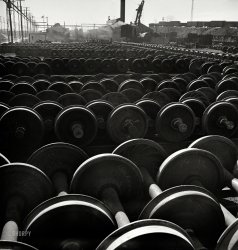
- Rio Grande: 1940
- September 1940. "Railroad yards. Durango, Colorado." Medium format negative by Russell Lee for ... is currently parked “out back” at the Chama yard with an uncertain future.
485, though, was the hard-luck kid of the ... Posted by Dave - 09/05/2018 - 3:03pm -
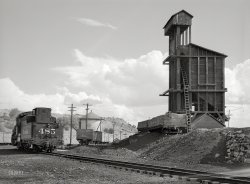
- Heroes' Welcome: 1919
- ...
At the time of this parade, there would have been a railroad switch yard between Michigan Avenue and a much smaller Grant Park. The tracks were ... Posted by Christoph Traugott - 11/12/2018 - 4:08pm -
![Heroes' Welcome: 1919 Chicago, May 12, 1919. "Return Parade for the 13th Railway Engineers, Michigan Boulevard." View full size. For another view, click here.
Thirteenth Engineers Returns to Chicago. The greatest reception given to any organization of returning soldiers at Chicago was given to the 13th Railway Engineers on May 12. Its welcome to its home town was unequaled in point of enthusiasm and spectacular expression in the after war history of the city. Approximately 100,000 people banked Michigan Boulevard on both sides and maintained a bedlam of noise as the regiment paraded in platoon formation. Employees of the six railroads centering in Chicago from which the 13th Engineers was mainly recruited were organized in groups along Michigan Boulevard to welcome the men.
-— Railway Age and Railway Review, 1919
During World War I, the regiment known as the 13th Engineers consisted of personnel from the six largest railroads that ran through Chicago; it operated about 142 kilometers of French railways, serving the Verdun-St. Mihiel, Champagne-Marne, and Meuse Argonne sections. The scan is from a family photo album titled "My Vacation Days," with dates ranging from 1914 to 1922.
Delayed ReturnI wonder if they really took this long from the end of the war to get back or if their skills were so sorely needed post-armistice that they had much work to do getting European railroads back into action again.
[It's the parade that was delayed. Because Chicago winters. - Dave]
Marching OrdersThe Michigan Avenue marchers are rapidly approaching the intersection of Michigan and E. Van Buren Street which would have crossed right in front of the tallest building in the picture to the left.
Except for the gabled building (4th from left-front) which has been replaced with a building which respects the design of the other two buildings to the left, all those buildings exist today, including the small 5-story building which now has a remodeled facade.
At the time of this parade, there would have been a railroad switch yard between Michigan Avenue and a much smaller Grant Park. The tracks were subsequently lowered and covered over to make a much larger Grant Park which now borders Michigan Avenue.
(ShorpyBlog, Member Gallery)](https://www.shorpy.com/files/images/rail_1_.thumbnail.jpg)
- Industrial Strength: 1901
- ... to the west of the Great Lakes Towing Company (G Tug) yard. The concrete framed drydock entrance is still there, visited it a few ... westward from the old lakefront depot. Beyond the railroad is where the Lakefront Ore Docks are now. The breakwall is apparently ... Posted by Dave - 05/28/2019 - 7:29pm -
